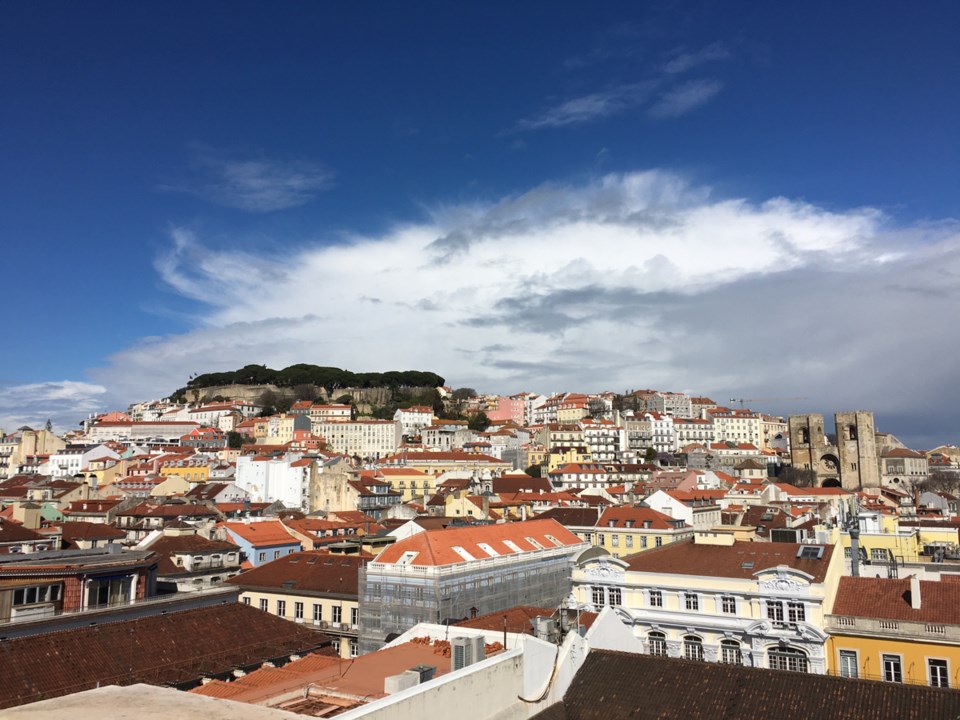One of Lisbon’s famous 80-year-old streetcars coasted to a stop ahead of us as we ascended the hill toward São Jorge (St. George) Castle. Along the narrow sidewalk, with my nine-month-old daughter in a carrier, I hugged the wall and let the German and Spanish tourists toe its lip.
We got in line for the streetcar, but commuters were already crowded like sticks in a matchbook. Our family was left to hoof it toward the picture-perfect ramparts in the distance. Tuk-tuks, sherpa-ing up tired tourists, zipped past us.
When Crusaders took the Moorish Castle in the 12th century, every step toward that fortress came with the extra burden of armour and weaponry. I had only a 17-pound-infant on my chest and yet I was ready to swear off any god for a rest. My wife’s pace had slowed and my 12-year-old stepson’s hunger-induced grumpiness was peaking. I pushed up the hill without complaint. This was my idea, after all. Not the castle, with its Lego-perfect ramparts, but a European visit with an infant — for the challenge? On most weeks, it’s hard enough to leave the house without forgetting an essential piece of baby gear or mom and dad squabbling. Why add jet lag and a language barrier?
We reached the castle grounds and ascended uneven steps up its granite walls near sunset. The view of the Portuguese capital — overlooking the tiled roofs of its medieval neighbourhoods, its cobblestone pedestrian streets and patio restaurants, with the Tagus River at the horizon — answered my questions. When we fed my stepson, he felt better, too.
A city famed for its nightclubs and alleyway tavernas ringing with lovelorn Fado melodies, Lisbon also proved a pleasant sight to wake up to. From our rooms in the Acores Hotel, our mornings were marked with a galão (espresso in foamy milk) and pastry and visits to museums such as the Calouste Gulbenkian, a mid-20th century oil baron’s art collection that spans from Egyptian antiquities to Claude Monet. In the afternoons, we shopped in stylish Principe Real, where we found Embaixada, a stylish suite of shops highlighting Portuguese designers in what was originally a 19th-century mansion.
When it came to meals, priority was given to the nearest eatery during those moments when meltdowns approached. Over salted cod at restaurants, waiters cooed at our tired baby, who never slept better than in Portugal. (My theory — the wine her mother drank at dinner.)
As always there were snags on our trip. Taking the wrong entrance to the Moorish Castle in Sintra, a hilltop getaway town for Lisbon’s aristocracy, meant a gruelling hour-long hike. This left us tired for the rest of the day in Sintra, which culminated at the Quinta da Regaleira. The highlight of our visit to the multi-turreted palace, which once belonged to an eccentric millionaire, was the system of tunnels he had built in the surrounding park.
My stepson loved the tunnels, which we entered by descending several stories into a well and exited from a pondside cave. And yet when I asked him about his favourite memory from that day, he mentioned our accidental hike. I didn’t recall him being a happy hiker, but he wasn’t having a case of selective memory. He was digesting new experiences, making sense of a situation that had stretched him. He was, in short, travelling.
And this was why I had wanted to visit Portugal. Since the baby had been born, the days had become matchy-matchy, a blur of laundry days and wet wipes. I wanted that sense of time widening to accommodate new sensations.
We regained our purchase on time in Lisbon, where each day began sketched lightly and was progressively shaded in on whim. Our wandering led us to Oceanarium, Lisbon’s aquarium, which we almost skipped because it was, well, another aquarium. The centrepiece of this family attraction, which was built for Expo 98, is a 5,000-cubic-metre tank that holds manta ray and zebra sharks. A wraparound pathway leads visitors from the top of the tank all the way down. It’s here we sat the baby on the ground to watch the bubble-eyed bottom feeders through the window. Because we’d wanted to please the baby, we had stumbled onto an unexpected delight for ourselves.
My daughter, of course, will hold no memory of our trip. She would have been happier with a cardboard box than a trip to Europe. But I hope she might internalize the agonies of air travel and routines of a day spent sightseeing for our next trip. By the time she’s old enough to remember her first travel experience, she will bring expectations without knowing why she has them.
Kevin Chong was a guest of Portugal Tourism and Visit Lisboa.
kkc19@columbia.edu



